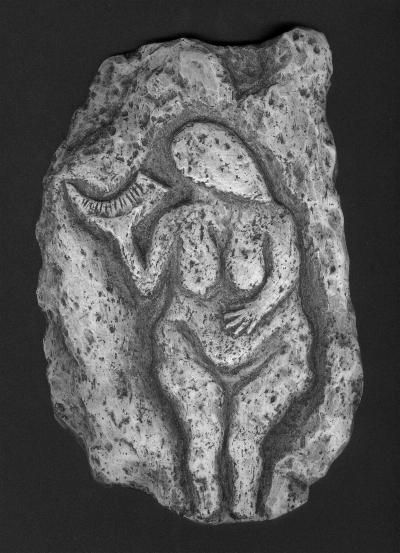
Dart and others have noted that the piece has three faces depending upon orientation. Face 1 shown; for Face 2 turn upside-down; obverse has Face 3. Dart interprets Face 2 as Australopithecine -like; Face 3 as possibly a toothless oldster. Bednarik suggest that Face 3 "presents a face resembling the reconstruction of an australopithecine face, wearing a friendly if somewhat mischievous grin". Face 1 would be too much like a current sapiens sapiens face. In either case, all agree that the individual who carried to the site had an 'iconographic' sense. This is the earliest evidence for aesthetic sense in the hominid line. Bednarik concludes based on this object that "it is, in my view, essential to expect australopithecine behavior to be significantly more complex, in a cultural and cognitive sense, than that of any extant non-human primate."
a) photo Patrick Nagel. Dart, R. (1974) . The waterworn Australopithecine pebble of many faces from Makapansgat. South African Journal of Science 70 (June):167-169, fig. 1. For a color photo see Bahn, P. and Vertut, J. (1997). Journey through the Ice Age. Berkeley: University of California Press. Figure 2.1. For a thorough microscopic and geological analysis see Bednarik, R. G. (1998). The 'Australopithecine' cobble from Makapansgat, South Africa. South African Archaeological Bulletin 53:4-8.

Two Bison

Bison bull and cow, modelled in clay in the rotunda of the Le Tuc d’Audoubert, Ariège, France
The sculptures are 63 and 61 cm long respectively from left to right. They probably cracked shortly after being made, as the clay dried. Although there are stalactites and stalgmites elsewhere in this cave system, there is no water dripping from the ceiling to destroy these sculptures. They are located at the very furthest point of a 900 metre cave, in a chamber reached only after an often uncomfortable and difficult journey.
===============================================
Spotted horse And Negative hand in printed

Signs, consisting of checks, dots, squares, or other arrangements of lines often accompany the pictures of animals. Representations of human hands also are common.
1-3: Spotted horses and negative hand imprints, wall painting in the cave at Pech-Merle, Lot, France, ca. 22,000 BCE. Approx. 11’ 2” long.
Infrared photography has revealed that the first horse, drawn in outline, was filled in over a period of time with sets of red and black spots applied both by blowing and by patting on the paint. Next, spots and handprints were placed around the horse. The smaller horse was drawn later. Alexander Marshack notes, "The sequence suggests a long-term, periodic, and variable ritual use of the wall and the horse."
==============================================
the Hall of bulls

Panoramic view of a cave wall
Lascaux, France, early period, 15,000-13,500 B.C.
Photograph courtesy of Musée de Périgord, Periguex,France
As many as 13 different styles are identifiable in the overlapping naturalistic figures painted on the walls of this cavern, each from a different time period. The largest bull, from the Great Hall of Bulls, measures 18 feet in length. Consider the remarkable abilities and observational capacities of these early artists: these paintings, among the earliest known, were made by the flickering light of oil-bearing stone lamps, almost certainly without the animals being present.
==============================================
Wounded man and disemboweled bison
Rhinoceros, wounded man and disemboweled bison
(Lascaux, France)
c. 15,000-13,000 BC Sometimes called the Well Scene owing to its location in a deeper, less accessible area in the caves of Lascaux, France. This is a good image to use early in the semester to encourage class participation concerning the various ways historians obtain information. As this is a prehistoric image, historians have to interact with anthropologists as well as art historians to arrive at reasonable interpretations of its meaning. We must also stress that with any prehistoric art any such interpretations are educated speculation and could be totally incorrect. General background: The artists were hunter-gatherers who, using flickering torchlight, painted such images in relatively inaccessible areas of certain caves. Because of their location most scholars believe that the paintings were meant to serve magical/religious purposes. It should also be noted that images of humans were rare and this is one of the first depictions of one of our early ancestors. |

No comments:
Post a Comment